More than half of the NCR cities and municipality have more women than men
In 2020, there were more women than men in the NCR. Among the 17 cities and municipality, eleven dominated by women – these include the Cities/Municipality of Manila, Mandaluyong, Marikina, Pasig, Quezon City, San Juan, Las Piñas, Makati, Parañaque, Pasay City, and Pateros. On the other hand, the Cities of Caloocan, Malabon, Navotas, Valenzuela, Muntinlupa, and Taguig had fewer women than men. The City of San Juan had the highest percentage of women among all, with 51.54 percent, while the City of Muntinlupa had the lowest with 48.55 percent. (Figure 1)

Most women of the NCR were residing in Quezon City
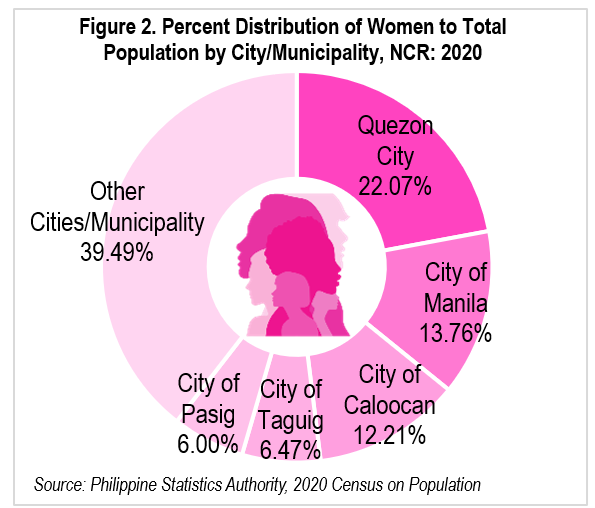
Among the 6.74 million women in the NCR, 22.07 percent resided in Quezon City, making it the city with the highest percentage of women residents. (Table A) Meanwhile, 13. 76 percent of women were in the City of Manila, and 12.21 percent were in the City of Caloocan. Further, there were 6.47 percent and 6.0 percent of women resided in the Cities of Taguig and Pasig, respectively. The remaining 39.49 percent were distributed across the other cities/municipality of the NCR. (Figure 2)
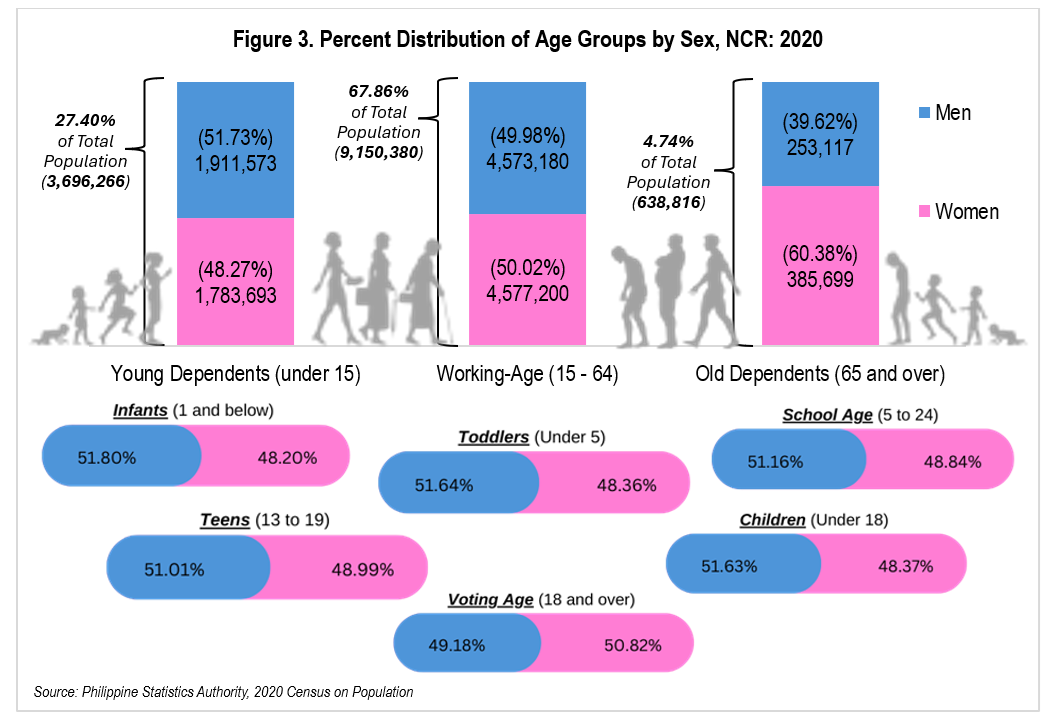
Women dominate the working population
The working-age population in the region, defined as individuals aged 15 to 64, was recorded at 9.15 million in 2020, making up 67.86 percent of the total population. Of this population, 4.58 million or 50.02 percent were women while 4.57 million or 49.98 percent were men. Among the young dependents, 1.91 million (51.73%) were men while 1.78 million were women (48.27%). For the old dependents, 3.85 thousand (60.38%) were women and 2.53 thousand (39.62%) were men. The voting age in the Philippines is 18 years old and above, while individuals under 18 years old are officially classified as children. Women made up 50.82 percent of the voting-age population in the region, higher than men at 49.18 percent. Women accounted for 48.73 percent of the child population, slightly higher than men at 48.37 percent. (Figure 3)
Higher number of births among men than women
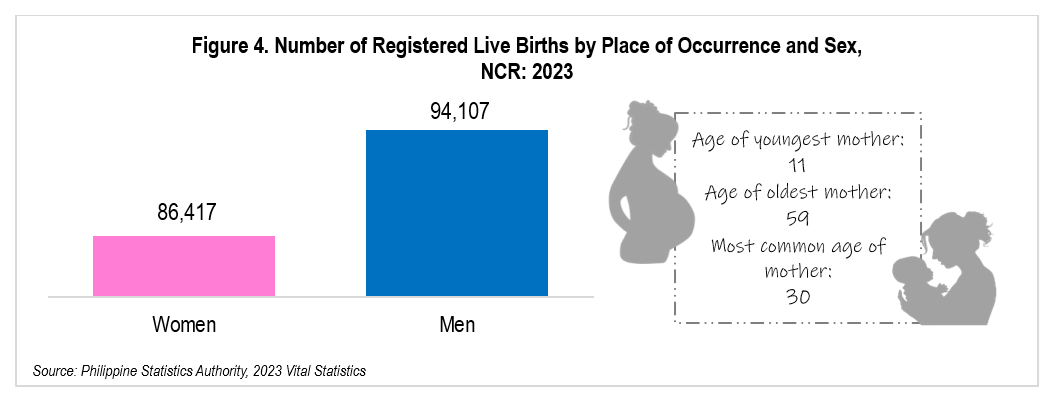
In 2023, there were more registered births among men, with 94,107 births, than among women, with 86,417 births. The youngest recorded mother was 11, while the oldest was 59. The most common age of mothers was 30 years old. (Figure 4)
Ischaemic heart diseases remain to be the leading cause of death

Among the 96,411 registered deaths occurred in the NCR, Ischaemic heart diseases remain the leading cause of death for both women and men accounting for 26.2 percent of the total deaths. Other leading causes of death included neoplasms, cerebrovascular diseases, diabetes, and pneumonia. (Figure 5)
Quezon City recorded the highest number of marriages
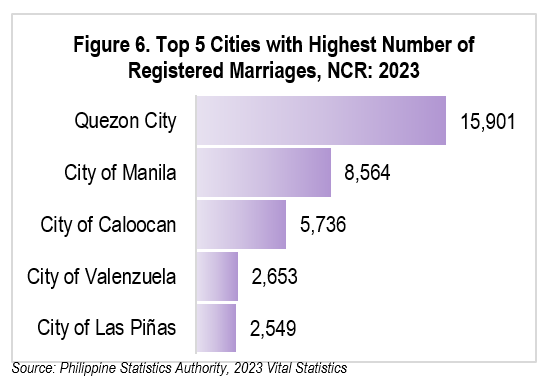
The NCR recorded a total of 51,892 marriages in 2023, with Quezon City having the highest number of registered marriages with 15,901, accounting for 30.6 percent of the total. It was followed by the City of Manila with 8,564 marriages (16.5%), City of Caloocan with 5,736 marriages (11.1%), City of Valenzuela with 2,653 marriages (5.1%), and the City of Las Piñas with 2,549 marriages (4.9%). (Figure 6)
Number of literate women were higher than men

Of the total 11.99 million literate individuals in the NCR in 2020, the number of literate women was higher than that of men in the older age groups, including those in the working-age (economically active) and old dependent groups. (Table B)
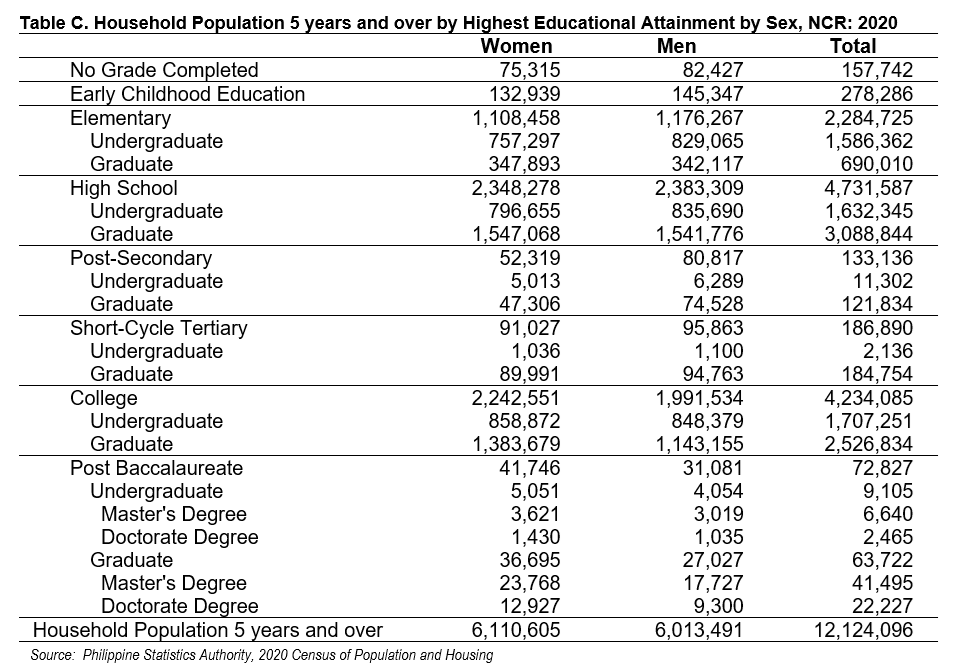
Women who reached post-baccalaureate levels totaled 41.7 thousand, 34.3 percent higher than men, who numbered 31.1 thousand. More women also attained a college education, with 2.24 million (53.0%) compared to 1.99 million (47.0%) men. Meanwhile, most people in the NCR aged 5 years old and over, reached at least high school level, with over 4.7 million attaining this level, making high school the most common level of attainment for both sexes. On the other hand, more men had no grade completed, with 82.4 thousand men compared to 75.3 thousand women. In addition, more men were recorded in early childhood education and short-cycle tertiary levels than women. (Table C)
9 in 10 women in the labor force were employed
In 2022, among the 53.73 percent of women in the labor force, 49.44 percent were employed while 4.29 percent were unemployed, indicating that about 9 out of every 10 women in the labor force had a job or work. Meanwhile, among men, 73.20 percent were in the labor force, with 67.09 percent employed and 6.12 percent unemployed also indicating that about 9 in 10 men in the labor force were employed. (Figure 7)
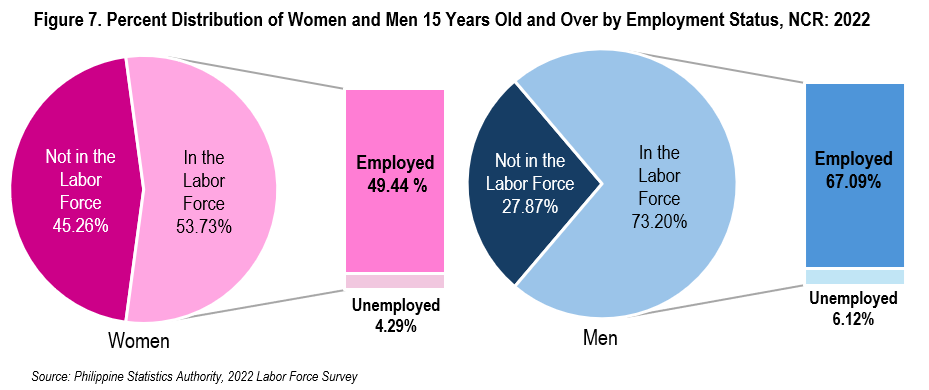
More than half of the employed women were wage and salary workers
Wage and salary workers continued to account for the largest share of employed women and men in the NCR. In 2022, seven out of ten women and almost nine out of ten men were wage and salary workers. This class of workers includes those who work for private households, private establishments, own family-operated farms or businesses, and government workers or government-controlled corporation workers. Meanwhile, 23.2 percent of employed women and 13.9 percent of employed men were own-account workers, which includes self-employed workers without any paid employee, as well as employers in their own family-operated farm or businesses. The remaining employed women and men were unpaid workers in their own family-operated farms or businesses. (Figure 8)
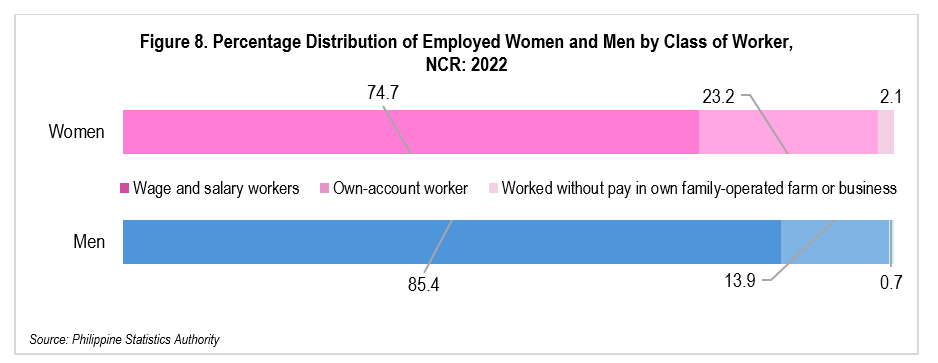
Most employed women and men recorded working in the Services sector
By percent of workers in the major industry group, the services sector continued to be the top sector in the NCR, accounting for 91.9 percent of employed women and 74.4 percent of employed men. The industry sector accounted for 8.0 percent of employed women and 25.0 percent of employed men, respectively. Meanwhile, 0.6 percent of employed men were in the Agriculture, Hunting, Forestry, and Fishing. (Figure 9)
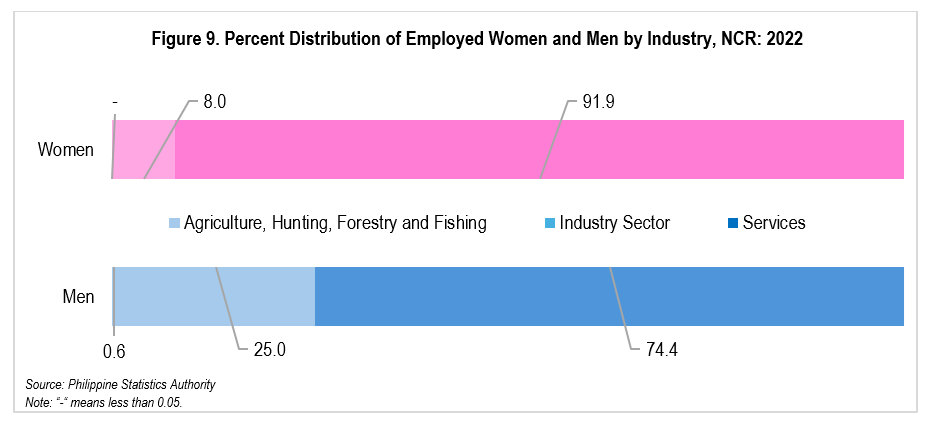
Among the employed women in the NCR in 2022, 7.0 percent were engaged in manufacturing, 0.9 percent in construction, and 0.1 percent in water supply, sewerage, waste management, and remediation activities. No employment of women was recorded in mining and quarrying, as well as in electricity, gas, steam, and air conditioning supply. On the other hand, 14.8 percent of employed men were in construction, followed by 9.5 percent in manufacturing, 0.4 percent in electricity, gas, steam, and air conditioning supply, 0.3 percent in water supply, sewerage, waste management, and remediation activities, and no employment of men was recorded in mining and quarrying. (Figure 10)
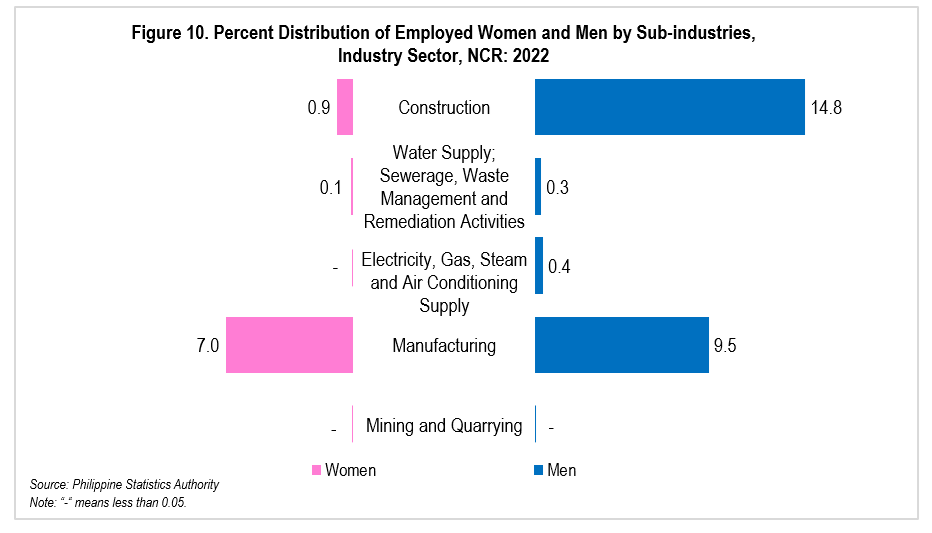

Most employed women in the services sector in the NCR in 2022, worked in wholesale and retail trade; repair of motor vehicles and motorcycles, making up 31.4 percent. This was followed by administrative and support service activities at 15.1 percent, and other service activities at 11.5 percent. Women were also present in accommodation and food services (6.6%), human health and social work (4.7%), public administration and defense (4.8%), and education (3.9%). Smaller shares of employed women were seen in finance, communication, real estate, and arts and entertainment. (Figure 11)
Among men, the highest share of employment was recorded in transportation and storage at 17.4 percent. This was followed closely by wholesale and retail trade (16.0%) and administrative and support service activities (14.1%). Other services with notable male employment included accommodation and food service activities (5.6%), public administration and defense (5.4%), and information and communication (3.1%). Men had lower shares in education (1.7%), health and social work (1.5%), and arts and entertainment (1.1%). The data shows that both women and men were mostly employed in wholesale and retail trade and administrative support, though their numbers varied across other service activities. (Figure 11)
Women leading in the service and clerical occupations
In 2022, women in the NCR were mostly employed in service and sales work, making up 36.2 percent of working women, much higher than the 21.0 percent of men in the same field. Clerical support was the second most common job for women at 21.7 percent, also higher than men’s 12.7 percent. Women were also employed in elementary occupations at 15.9 percent, though slightly lower than the 19.2 percent of men. (Figure 12)
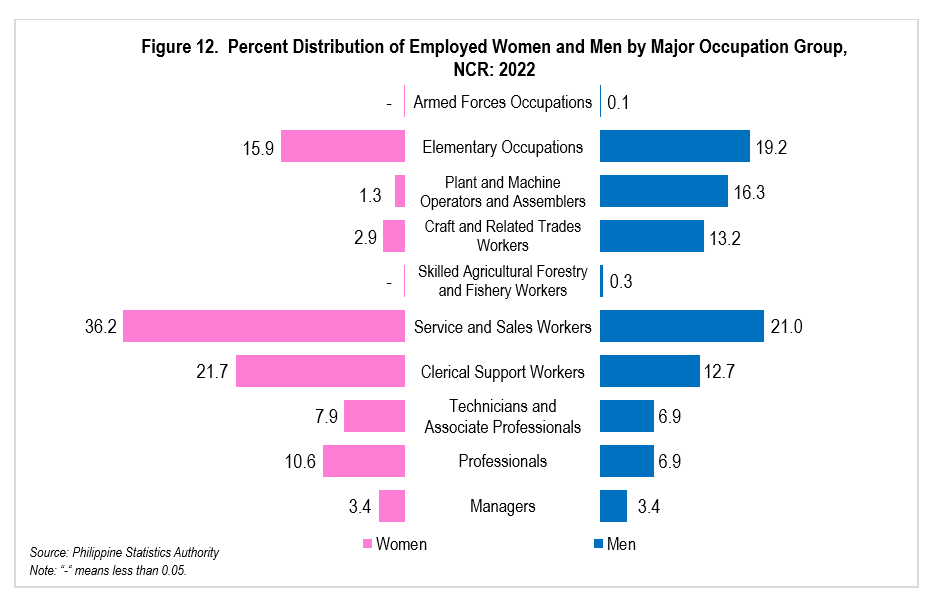
Occupations such as plant and machine operators and assemblers were mostly held by men (16.3%), while only 1.3 percent of women working in this field. The same goes for craft and related trades, where 13.2 percent of men were employed, compared to only 2.9 percent of women. No women were recorded in skilled agricultural, forestry, and fishery work, while 0.3 percent of men had jobs in this group. (Figure 12)
In professional roles, 10.6 percent of women were employed, compared to 6.9 percent of men. Women also had a slightly higher share in technician and associate professional jobs at 7.9 percent, while men made up 6.9 percent. Both genders had equal representation in managerial roles at 3.4 percent. Armed forces occupations had very low participation overall, with only 0.1 percent of men and no women employed.
These figures, numbers, and percentages show that women in the NCR are mostly working in service, clerical, and professional jobs, while men are more likely to be in manual, technical, and trade-related occupations. (Figure 12)
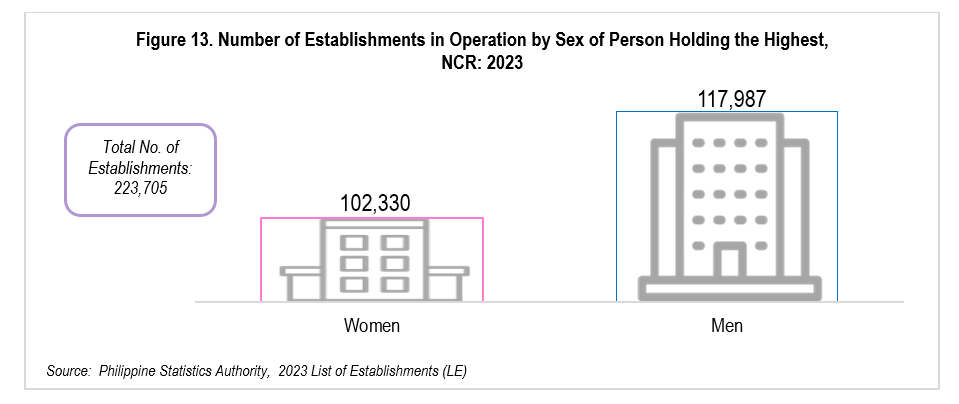
Women Hold Nearly Half of Top Positions in NCR Establishments in 2023
Of the total 223,705 establishments in operation in the NCR in 2023, 102,330
(45.74%) were led by women, while 117,987 (52.74%) were headed by men. While men still held a slightly larger share of top positions, the data highlights a strong presence of women in leadership roles, with nearly half of all establishments under their direction. (Figure 13)
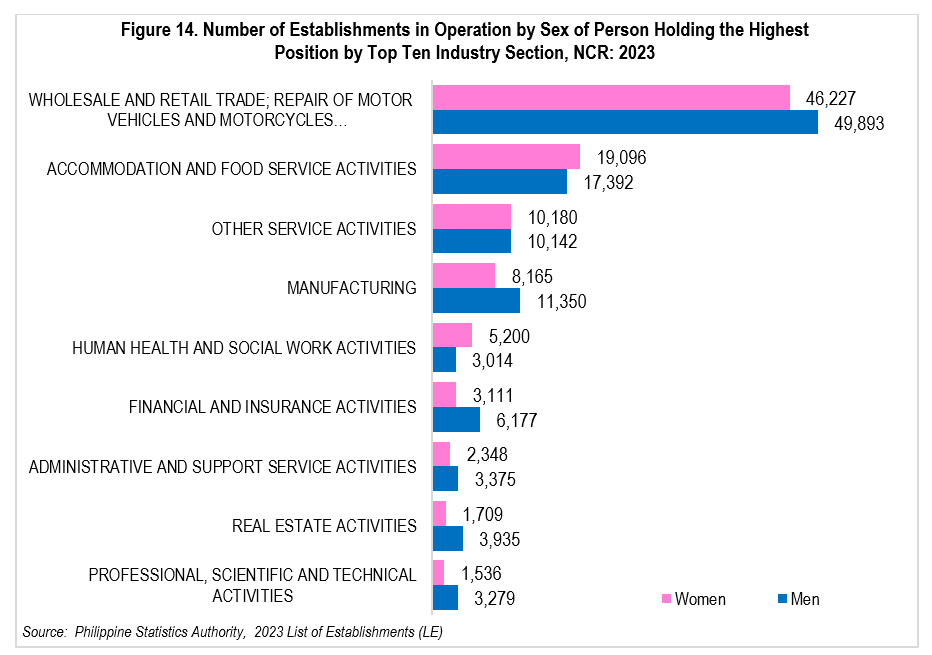
Among the top ten industries with the highest number of establishments operating in the NCR in 2023, women held the highest position of most establishments in accommodation and food service activities and human health and social work activities. While men led most establishments in wholesale and retail trade, repair of motor vehicles and motorcycles, manufacturing, financial and insurance activities, administrative and support service activities, real estate activities, professional, scientific, and technical activities. (Figure 14)
(Sgd.) PACIANO B. DIZON
Regional DIrector
